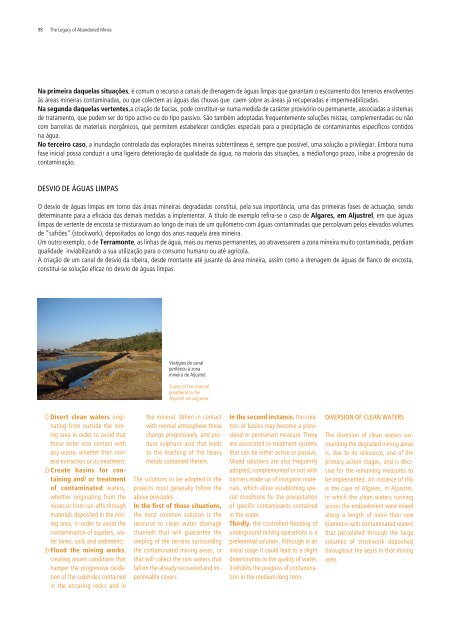Livro EDM
"A Herança das Minas Abandonadas - O Enquadramento e a Situação em Portugal"
"A Herança das Minas Abandonadas - O Enquadramento e a Situação em Portugal"
Create successful ePaper yourself
Turn your PDF publications into a flip-book with our unique Google optimized e-Paper software.
98 The Legacy of Abandoned Mines<br />
Na primeira daquelas situações, é comum o recurso a canais de drenagem de águas limpas que garantam o escoamento dos terrenos envolventes<br />
às áreas mineiras contaminadas, ou que colectem as águas das chuvas que caem sobre as áreas já recuperadas e impermeabilizadas.<br />
Na segunda daquelas vertentes,a criação de bacias, pode constituir-se numa medida de carácter provisório ou permanente, associadas a sistemas<br />
de tratamento, que podem ser do tipo activo ou do tipo passivo. São também adoptadas frequentemente soluções mistas, complementadas ou não<br />
com barreiras de materiais inorgânicos, que permitem estabelecer condições especiais para a precipitação de contaminantes específicos contidos<br />
na água.<br />
No terceiro caso, a inundação controlada das explorações mineiras subterrâneas é, sempre que possível, uma solução a privilegiar. Embora numa<br />
fase inicial possa conduzir a uma ligeira deterioração da qualidade da água, na maioria das situações, a médio/longo prazo, inibe a progressão da<br />
contaminação.<br />
DESVIO DE ÁGUAS LIMPAS<br />
O desvio de águas limpas em torno das áreas mineiras degradadas constitui, pela sua importância, uma das primeiras fases de actuação, sendo<br />
determinante para a eficácia das demais medidas a implementar. A título de exemplo refira-se o caso de Algares, em Aljustrel, em que águas<br />
limpas de vertente de encosta se misturavam ao longo de mais de um quilómetro com águas contaminadas que percolavam pelos elevados volumes<br />
de “safrões” (stockwork), depositados ao longo dos anos naquela área mineira.<br />
Um outro exemplo, o de Terramonte, as linhas de água, mais ou menos permanentes, ao atravessarem a zona mineira muito contaminada, perdiam<br />
qualidade inviabilizando a sua utilização para o consumo humano ou até agrícola.<br />
A criação de um canal de desvio da ribeira, desde montante até jusante da área mineira, assim como a drenagem de águas de flanco de encosta,<br />
constitui-se solução eficaz no desvio de águas limpas.<br />
Vestígios do canal<br />
periférico à zona<br />
mineira de Aljustrel.<br />
Traces of the channel<br />
peripheral to the<br />
Aljustrel mining area.<br />
1) Divert clean waters originating<br />
from outside the mining<br />
area in order to avoid that<br />
these enter into contact with<br />
any waste, whether from mineral<br />
extraction or its treatment;<br />
2) Create basins for containing<br />
and/ or treatment<br />
of contaminated waters,<br />
whether originating from the<br />
mines or from run-offs through<br />
materials deposited in the mining<br />
area, in order to avoid the<br />
contamination of aquifers, water<br />
lanes, soils and sediments;<br />
3) Flood the mining works,<br />
creating anoxic conditions that<br />
hamper the progressive oxidation<br />
of the sulphides contained<br />
in the encasing rocks and in<br />
the mineral. When in contact<br />
with normal atmosphere these<br />
change progressively, and produce<br />
sulphuric acid that leads<br />
to the leaching of the heavy<br />
metals contained therein.<br />
The solutions to be adopted in the<br />
projects must generally follow the<br />
above principles.<br />
In the first of those situations,<br />
the most common solution is the<br />
recourse to clean water drainage<br />
channels that will guarantee the<br />
seeping of the terrains surrounding<br />
the contaminated mining areas, or<br />
that will collect the rain waters that<br />
fall on the already recovered and impermeable<br />
covers.<br />
In the second instance, the creation<br />
of basins may become a provisional<br />
or permanent measure. These<br />
are associated to treatment systems<br />
that can be either active or passive.<br />
Mixed solutions are also frequently<br />
adopted, complemented or not with<br />
barriers made up of inorganic materials,<br />
which allow establishing special<br />
conditions for the precipitation<br />
of specific contaminants contained<br />
in the water.<br />
Thirdly, the controlled flooding of<br />
underground mining operations is a<br />
preferential solution. Although in an<br />
initial stage it could lead to a slight<br />
deterioration in the quality of water,<br />
it inhibits the progress of contamination<br />
in the medium/long term.<br />
DIVERSION OF CLEAN WATERS<br />
The diversion of clean waters surrounding<br />
the degraded mining areas<br />
is, due to its relevance, one of the<br />
primary action stages, and is decisive<br />
for the remaining measures to<br />
be implemented. An instance of this<br />
is the case of Algares, in Aljustrel,<br />
in which the clean waters running<br />
across the embankment were mixed<br />
along a length of more than one<br />
kilometre with contaminated waters<br />
that percolated through the large<br />
volumes of stockwork deposited<br />
throughout the years in that mining<br />
area.


